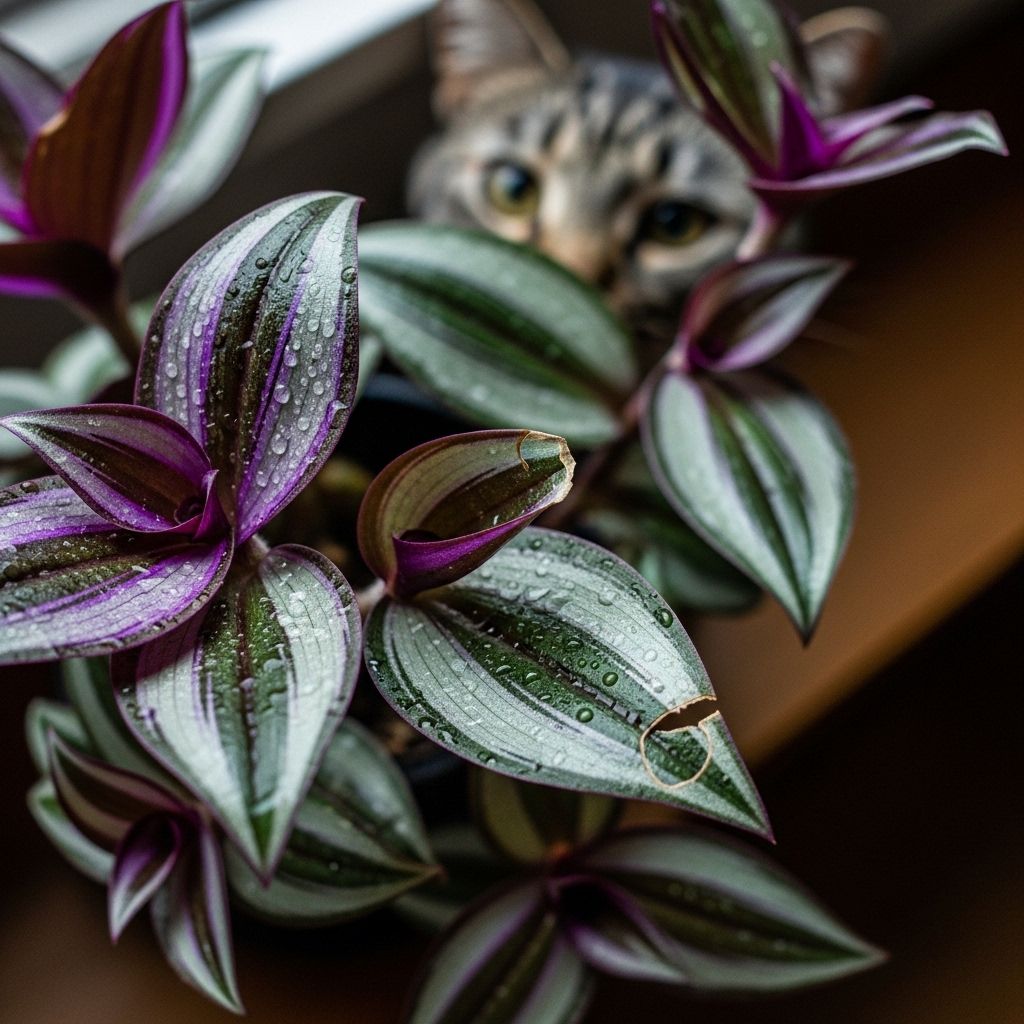Wandering Jew Plant Toxic To Cats: A Comprehensive Guide
Discover the risks, symptoms, and safety strategies for cat owners with Wandering Jew plants in the home.

Image: HearthJunction Design Team
Wandering Jew Plant and Cats: A Comprehensive Guide to Risks, Symptoms, and Safe Home Practices
The Wandering Jew plant, known botanically as Tradescantia (including species such as Tradescantia fluminensis), is a common houseplant lauded for its cascading vines and vibrant foliage. Yet, for cat owners, a vital question arises: Is the Wandering Jew plant safe for cats? This guide explores the potential toxicity of this plant, associated signs and symptoms in pets, and effective strategies for a pet-safe home.
Understanding the Wandering Jew Plant
The Wandering Jew plant belongs to the Commelinaceae family and encompasses several species, including Tradescantia fluminensis, Tradescantia zebrina, and Tradescantia pallida. Characterized by trailing stems and visually appealing striped leaves, it’s a favorite in homes and gardens worldwide.
- Common Names: Wandering Jew, Inch Plant, Speedy Henry, Wandering Willy
- Typical Use: Houseplant, ground cover in gardens
- Noted For: Fast-growing vines, low-maintenance care, and decorative foliage
Is the Wandering Jew Plant Poisonous to Cats?
Yes, the Wandering Jew plant is considered potentially toxic to cats. The main risk arises from sap within the stems, which contains irritating compounds, notably calcium oxalate crystals, that can mechanically irritate a cat’s mouth and digestive tract if chewed or ingested. However, serious toxicity is relatively rare, and mild gastrointestinal and skin reactions are more common.
- Most reactions occur after ingestion of the plant’s sap or leaves.
- Calcium oxalates are the primary irritant, causing immediate discomfort.
- It is the mechanical irritation—not classic toxin poisoning—that affects cats.
Comparative Toxicity Table: Wandering Jew vs. Other Common Houseplants
| Plant Name | Main Irritant/Toxin | Primary Symptoms in Cats | Severity |
|---|---|---|---|
| Wandering Jew (Tradescantia) | Calcium Oxalate Crystals, Sap | Oral irritation, vomiting, drooling, dermatitis | Mild to moderate |
| Dieffenbachia | Insoluble Calcium Oxalates | Swelling, pain, drooling | Moderate to severe |
| Lilies | Unknown specific toxins | Kidney failure | Severe, life-threatening |
| Philodendron | Calcium Oxalates | Oral pain, swelling | Moderate |
Symptoms of Wandering Jew Plant Exposure in Cats
The severity and type of symptoms depend on the extent of the cat’s exposure. Most commonly, cats experience gastrointestinal upset or skin irritation after contact with the plant. Reactions may vary from mild to moderate and are typically not life-threatening.
Common Signs of Ingestion
- Mouth irritation: Pawing at the face, excessive drooling
- Vomiting: Usually mild and self-limited
- Loss of appetite
- Oral redness or swelling
Common Signs of Skin Contact
- Redness or rash: Especially on hairless areas, paws, chin, abdomen, or chest
- Itching, scratching, or licking
- Ulceration and blisters: In severe or repeated contact cases
- Conjunctivitis or eye irritation
Toxic Compound: Why Is It Harmful?
The sap of Wandering Jew plants contains needle-like calcium oxalate crystals, which are responsible for most of the plant’s negative effects on pets. When cats chew on leaves or stems, these crystals embed into delicate tissues, causing mechanical irritation—leading to pain, swelling, and inflammation.
“The plant has sap within the stems that will bother your cat’s digestive tract. It’s important to note that usually there isn’t a toxic reaction…”
How Does the Plant Affect Cats?
- Mechanical irritation: Due to sharp, microscopic crystals
- Contact dermatitis: The sap can irritate skin, especially in sensitive or hairless areas
- Secondary infection: Scratching or licking irritated skin may lead to bacterial infection
What to Do If Your Cat Is Exposed
If you suspect or witness your cat chewing, licking, or coming into contact with the Wandering Jew plant, follow these steps:
- Remove Access: Relocate your cat and remove the plant or any fallen leaves.
- Rinse Mouth or Skin: Gently wipe your cat’s mouth or wash the affected skin with lukewarm water to remove plant residue.
- Monitor: Observe your cat for symptoms such as drooling, vomiting, or itching.
- Veterinary Care: If symptoms persist beyond a few hours, worsen, or if your cat seems lethargic or in pain, contact your veterinarian immediately.
Veterinary Treatment for Exposure
In most cases, mild exposure requires only supportive care: withdrawal of the plant, monitoring, and gentle washing. For more severe reactions, especially skin irritation or persistent gastrointestinal upset, vets may recommend:
- Oral or topical antihistamines or steroids
- Ointments to soothe skin and control itching
- Antibiotics (if a secondary skin infection develops)
- Fluids or anti-nausea medication (for persistent vomiting)
Preventing Exposure: Pet-Safe Plant Strategies
Prevention is the most effective strategy to protect your cat. Here are practical steps you can take:
- Place plants out of reach: Choose hanging baskets or high shelves that cats can’t access.
- Train and deter: Use pet deterrent sprays or double-sided tape to discourage chewing behaviors.
- Enrich your cat’s environment: Provide safe plants (cat grass, catnip) and interactive toys as alternatives.
- Regularly inspect plants: Check for and promptly remove any fallen leaves or stems.
- Choose alternatives: Replace Wandering Jew with truly non-toxic, cat-safe houseplants.
Pet-Safe Alternatives to Wandering Jew
- Spider plant (Chlorophytum comosum): Non-toxic and visually similar in trailing form
- Bamboo palm (Chamaedorea seifrizii)
- Boston fern (Nephrolepis exaltata)
- Areca palm (Dypsis lutescens)
- Catnip (Nepeta cataria): A favorite enrichment plant for felines
Frequently Asked Questions (FAQs)
Q: Is the Wandering Jew plant deadly to cats?
A: No, the plant is not typically deadly. Most cats who chew on Wandering Jew experience mild to moderate oral or skin irritation that resolves with supportive care. Severe poisoning is highly unlikely.
Q: Can cats get sick from just touching the plant?
A: Yes, direct skin contact can cause localized irritation, redness, and itching—especially in sensitive or hairless areas. This is known as contact dermatitis and is usually self-limited but can lead to secondary infections if scratched excessively.
Q: How much of the plant must a cat eat to cause problems?
A: Even small amounts can cause discomfort due to the calcium oxalate crystals. Severity depends on the individual cat’s sensitivity and the amount ingested, but large, life-threatening reactions are rare.
Q: What should I do if my cat vomits after chewing on a Wandering Jew plant?
A: Remove any remaining plant matter, offer water, and monitor closely. Most cats recover quickly, but consult your veterinarian if vomiting persists, or if you see signs of distress such as persistent drooling, swelling, or lethargy.
Q: Can dogs or other pets be affected by Wandering Jew plants?
A: Yes, dogs can experience skin irritation and allergic reactions, particularly on the paws, chest, or abdomen. Birds and small mammals may be similarly at risk if they come into contact with or ingest the plant.
Q: How can I tell if my houseplants are safe for pets?
A: Consult lists provided by reputable veterinary organizations (such as the ASPCA) or your veterinarian. Look for plants labeled as non-toxic and always supervise introductions of new plants in a pet-inhabited home.
Key Takeaways: Wandering Jew Plant and Cat Safety
- The Wandering Jew plant (Tradescantia species) can cause mild to moderate oral and skin irritation in cats if ingested or touched.
- Symptoms include vomiting, drooling, mouth swelling, and skin redness or rash.
- Serious or life-threatening toxicity is extremely rare.
- Prevention—through inaccessible placement or plant selection—is the best way to protect your pets.
- Consult your veterinarian if your cat shows symptoms after exposure to the plant.
Further Resources
- Contact your local veterinarian for advice on toxic plant exposures.
- Check the ASPCA Toxic and Non-Toxic Plants List for comprehensive guidance.
- Explore pet-friendly houseplant guides for safe alternatives.
Conclusion
While the Wandering Jew plant is a popular decorative houseplant, its potential to cause oral and skin irritation in cats means cat owners should exercise caution. Preventing access, recognizing the signs of plant-related distress, and knowing what steps to take in case of exposure are essential for a harmonious home shared by both plants and pets.
References
Read full bio of Srija Burman












